
|
KIT: |
Trumpeter 1/32 F4F-4 Wildcat |
|
KIT # |
2223 |
|
PRICE: |
$49.95 MSRP |
|
DECALS: |
One aircraft - Joe Foss at Guadalcanal |
|
REVIEWER: |
Tom Cleaver |
|
NOTES: |

|
HISTORY |
Marion Carl and the Wildcat:
Marion E. Carl entered the NavCad program following his graduation from the University of Oregon in 1938, and joined the Marines following flight training. By the outbreak of war in December, 1941, he was arguably one of the best pilots in Marine aviation, with 1,300 flying hours - most of that in fighters. As a newly-promoted Captain, he was assigned to VMF-221, which was sent aboard USS “Saratoga” in an attempt to reinforce Wake Island. With the failure of that mission, VMF-221 flew their F2A-3 Buffalos off “Saratoga” to become the fighter defense of Midway Island.
In late May, 1942, VMF-221 learned the Japanese were coming. On May 26, the unit was reinforced with the addition of seven F4F-3 Wildcats. Carl was among the pilots given the new airplanes, logging 5.5 hours in the Wildcat in the week before the Japanese attack.
 At 0555, June 4, 1942, Midway radar detected a
large formation inbound from the northwest - 107 Japanese aircraft from
“Akagi” and “Kaga” were 90 miles out, inbound. 25 Buffaloes and Wildcats
were airborne within 10 minutes. In the confusion, division organization
broke down, and the fighters were in two formations - one with 7 Buffalos
and 5 Wildcats led by Squadron CO MAJ Floyd Parks that intercepted the
raid, and the other consisting of 11 Buffalos and one Wildcat that
orbited ten miles out and were intercepted themselves before being able
to attack the intruders.
At 0555, June 4, 1942, Midway radar detected a
large formation inbound from the northwest - 107 Japanese aircraft from
“Akagi” and “Kaga” were 90 miles out, inbound. 25 Buffaloes and Wildcats
were airborne within 10 minutes. In the confusion, division organization
broke down, and the fighters were in two formations - one with 7 Buffalos
and 5 Wildcats led by Squadron CO MAJ Floyd Parks that intercepted the
raid, and the other consisting of 11 Buffalos and one Wildcat that
orbited ten miles out and were intercepted themselves before being able
to attack the intruders.
VMF-221 was cut to pieces by the 36 Zeros that were escorting the 71 Kates and Vals of the strike force. The Marines were inexperienced and up against some of the best pilots in the Japanese Navy - meaning they were some of the best in the world. In the circumstances, it is not surprising that of 19 F2A-3s which engaged the enemy, 13 were shot down and of the six survivors only one was in condition to fly a second mission. Marion Carl was leading a 3-plane section in Park’s formation with CAPT John Carey and 1LT Clayton Canfield. 30 miles out, the trio spotted the Japanese and rolled into a gunnery pass from 14,000 feet. Canfield flamed one Val while Carey attacked a second, but both pilots were set upon by two sections of Zeros. Carey was wounded in the leg, but managed to land safely despite being unable to use the rudder; Canfield’s Wildcat was so shot-up it collapsed on touchdown.
Carl pulled out, saw lots of Zeros and began climbing for altitude. At 20,000 feet, he turned back to Midway. He was suddenly attacked by a Zero, which he finally evaded by diving vertically and throwing the Wildcat into a skid the Zero couldn’t follow; the Japanese fighter overshot, but when Carl pulled the trigger he discovered his guns were jammed due to negative-G. He evaded that Zero and then ran across three others. Clearing his guns, he made a high stern approach and blew the third Zero out of the sky before the others knew he was there. Returning to Midway, Carl discovered his was the only Wildcat left that was fit to fly. He was awarded his first Navy Cross for his actions this day.
 Two months later, the U.S. began its first
offensive of the war with the invasion of Guadalcanal on August 7. After
a Japanese surface strike took out four cruisers, the Navy withdrew their
transports in the face of a possible Japanese attack, leaving the First
Marine Division to face the enemy alone with less than half their
supplies delivered. Beginning on August 18, the Japanese 25th Air
Flotilla began regular bombing of the island. Marine Air Group-23, which
had only been formed the previous May, had been selected in July to
provide air defense on Guadalcanal. At that time, the two fighter
squadrons were still equipped with F2A-3s, while the two dive bomber
squadrons had old SBD-2s. The forward echelon - VMF-223 and VMSB-232 -
were quickly re-equipped with new F4F-4 Wildcats and SBD-3 Dauntlesses.
Among the pilots transferred in were three survivors of VMF-221: Marion
Carl, Clayton Canfield and Roy Corry, to provide some “veterans” (such as
they were). The squadron had barely six weeks to learn combat flying
techniques and get carrier-qualified for their mission. Fortunately,
gunnery was a fetish with CO MAJ John L. Smith, and most training was put
on this.
Two months later, the U.S. began its first
offensive of the war with the invasion of Guadalcanal on August 7. After
a Japanese surface strike took out four cruisers, the Navy withdrew their
transports in the face of a possible Japanese attack, leaving the First
Marine Division to face the enemy alone with less than half their
supplies delivered. Beginning on August 18, the Japanese 25th Air
Flotilla began regular bombing of the island. Marine Air Group-23, which
had only been formed the previous May, had been selected in July to
provide air defense on Guadalcanal. At that time, the two fighter
squadrons were still equipped with F2A-3s, while the two dive bomber
squadrons had old SBD-2s. The forward echelon - VMF-223 and VMSB-232 -
were quickly re-equipped with new F4F-4 Wildcats and SBD-3 Dauntlesses.
Among the pilots transferred in were three survivors of VMF-221: Marion
Carl, Clayton Canfield and Roy Corry, to provide some “veterans” (such as
they were). The squadron had barely six weeks to learn combat flying
techniques and get carrier-qualified for their mission. Fortunately,
gunnery was a fetish with CO MAJ John L. Smith, and most training was put
on this.
VMF-223 arrived on Guadalcanal August 20, 1942, launched from the U.S.S. “Long Island.” The pilots had packed their planes with everything they could stuff in a Wildcat - spark plugs, starter cartridges, tool kits, even spare tires.
Henderson Field on Guadalcanal was a 3,800-foot strip 150 feet wide, lying within a tenuously held defensive line that put the aircraft within range of Japanese artillery. There were no facilities or revetments for protection; aircraft maintenance would be a test of American ingenuity throughout their tour on the island. They would find themselves chronically short of oxygen bottles, all manner of parts and equipment, and - frequently - gasoline. All thought of individually-assigned aircraft was put aside as damaged airplanes became sources of spare parts for those remaining, and pilots flew whichever airplane was available that worked.
VMF-221 entered combat the next day, and between August 21-23, claimed five victories for one loss. Their first real test came August 24, when six Kates and 15 Zeros were launched from the Japanese carrier “Ryujo,” to rendezvous with 20 Betty bombers and knock out Henderson Field. Marion Carl’s division made first contact as he led the 4 Wildcats into an overhead pass on the Japanese, nailing one Zero. As the fight broke up into a general engagement over the field, Carl shot down two Bettys and another Zero, making him the first Marine ace of the war. VMF-223 came out of the fight claiming 20 victories, for three pilots killed. The second echelon of MAG-23 arrived six days later to provide crucial reinforcement. Carl received his second Navy Cross for this action.
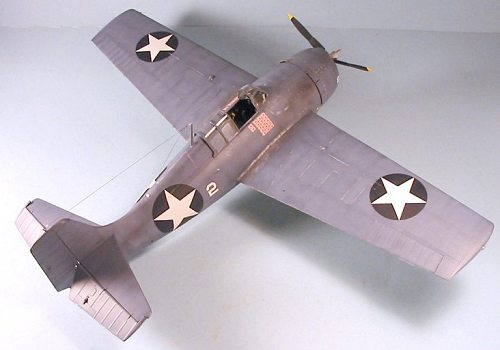 Air fighting over the island took on a
schedule, with the Japanese running a formation of Bettys with Zero
escorts down “the slot” from Rabaul every day, weather permitting, to
arrive over Guadalcanal between 1100 and 1300. And every day they found
the Marines waiting for them, thanks to the warnings radioed in from
Australian and New Zealand coastwatchers. The Wildcats needed every
minute of advance warning they could get, since it took 45 minutes to
launch all fighters and get them to 20,000 feet ahead of the Japanese.
Air fighting over the island took on a
schedule, with the Japanese running a formation of Bettys with Zero
escorts down “the slot” from Rabaul every day, weather permitting, to
arrive over Guadalcanal between 1100 and 1300. And every day they found
the Marines waiting for them, thanks to the warnings radioed in from
Australian and New Zealand coastwatchers. The Wildcats needed every
minute of advance warning they could get, since it took 45 minutes to
launch all fighters and get them to 20,000 feet ahead of the Japanese.
By September 9, Carl’s score stood at 11 when he replaced John L. Smith to lead an interception of 36 Betty’s over The Slot. Carl shot down two, but a Zero slipped in behind him and shot out the oil lines in his Wildcat. With an in-flight fire, Carl bailed out of the airplane he had flown for 11 of his victories. Landing in Ironbottom Sound, he treaded water for 4 hours until a native rescued him and brought him to the northern end of Guadalcanal. After turning back from an attempt on September 12 to walk to Henderson Field due to the presence of Japanese troops, Carl and a Fijian medic named Eroni found a dilapidated motorboat and managed to get it running; they were able to return to US-held territory on September 14, where Carl discovered all his personal effects had been doled out to others and his bunk assigned to a replacement already. Two weeks of driving rain that began that day provided a needed respite for the Marines and the recently-arrived Navy pilots of VF-5.
The break ended on September 27, when 18 Bettys and 38 Zeros were spotted late, only 100 miles north. The Marines were not able to intercept until the Japanese were already in their bombing runs. Carl scored one Betty and shared a second. The next day, with plenty of warning, 33 Wildcats intercepted 27 Bettys and 44 Zeros, claiming 23 of the 27 bombers shot down. Carl’s score this day brought his total to 15.5. Japanese tactics changed after this, with large “fighter sweeps” of 30-36 Zeros escorting a small number of Bettys which turned away at the last moment, in an attempt to wear down the American defenders by fighter-to-fighter attrition. The first two sweeps did just that, with the Japanese ahead in scoring - 2-1 on the first sweep and 6-4 on the second. The third sweep, on October 3rd, saw Carl score his last victory at Guadalcanal, a Zero shot down in a low-altitude fight over Henderson Field.
 VMF-223 flew their last mission on October
10. When they departed Guadalcanal on October 12, they had taken 43
percent casualties among the pilots, and scored 110 victories, including
47 Zeros and 47 Bettys. John L. Smith and Marion Carl shot down more
twin-engine Japanese airplanes than any other Marine pilots during the
war - 10 and 8 respectively.
VMF-223 flew their last mission on October
10. When they departed Guadalcanal on October 12, they had taken 43
percent casualties among the pilots, and scored 110 victories, including
47 Zeros and 47 Bettys. John L. Smith and Marion Carl shot down more
twin-engine Japanese airplanes than any other Marine pilots during the
war - 10 and 8 respectively.
As General Carl related to me in 1992, on October 15, 1942, he was summoned to HQ on Espiritu Santo and informed he would participate in a press conference in two hours, during which he was to tell the reporters of his experiences fighting over Guadalcanal. The squadron had left their airplanes at Henderson Field to be used by their replacements. He and a Master Gunnery Sergeant found a “hangar queen” F4F-4 on the airfield, which they chose because its side number was “2" and he was the second-ranked Marine ace behind John L. Smith at the time, and quickly stuck 17 Japanese flag stickers under the cockpit to both sides. Photographs of Carl sitting on the wing of this non-flyable Wildcat were widely published, and the airplane has been considered “Marion Carl’s Wildcat” ever since.
Carl returned to combat in the Solomons as CO
of VMF-223, flying Corsairs, in August 1943. VMF-223 took part in the
epic “Battle of Rabaul” that fall, during which he scored two more
victories to bring his total to 18.5. During the course of two combat
tours, Carl was awarded two Navy Crosses, three Distinguished Flying
Crosses, and 13 Air Medals. Following the end of the war, he became a
test pilot. On November 1, 1946, he performed the first landing of a jet
airplane aboard an aircraft carrier, when he put a hooked F-80 aboard the
“Shangri-La.” On August 25, 1947, flying the Douglas D-558-1 “Skystreak,”
he set a world air speed record of 651 mph. In 1953, flying the D-558-2
“Skyrocket,” he set a world altitude
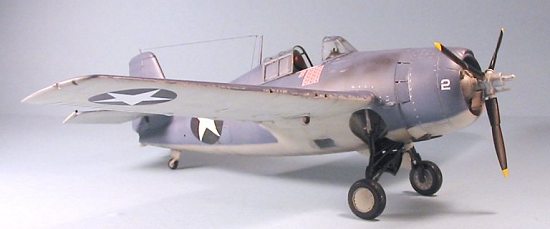 record of 83,235 feet. In 1955, as
CO of VMJ-1, he flew F2H-2P photo Banshees on reconnaissance missions
over Red China. He retired from the Marine Corps as a Major General.
record of 83,235 feet. In 1955, as
CO of VMJ-1, he flew F2H-2P photo Banshees on reconnaissance missions
over Red China. He retired from the Marine Corps as a Major General.
As with everyone who was ever fortunate enough to meet this gracious man who never held himself out as any sort of “hero,” I was shocked and saddened to learn in June, 1998, of his death at age 83, the victim of a teenage drug addict who broke into his home looking for money to buy drugs. The death was a tragic irony, that a man who had met in battle and prevailed over the best the enemy had to offer, died at the end of a successful life at the hand of a worthless punk who would have made the world better by having never been born. The killer awaits execution in Oregon as this is written; I am personally opposed to the death penalty, but in this case I would volunteer to flip the switch.
In recent years there has been a small but dedicated effort to recognize Marion Carl's heroism with a posthumous Medal of Honor. Surely he deserves it.
|
THE KIT |
For a look at what’s in the box please visit the preview.
|
CONSTRUCTION |
Construction of this model started with a
decision about what to leave out. Having read Scott Van Aken’s review of
the Trumpeter Corsair,
and a comment by another modeler who had built this kit over at
HyperScale to the effect that he could only build it with wings folded, I
decided I was not going to tempt the fates of an over-engineered kit.
Thus, construction began with the wings. I
did each upper and lower half of the wing in turn, gluing the inner and
outer sections together along the fold break, reinforcing the joints on
the inside with Evergreen sheet plastic, as seen in the accompanying
photo. I then glued the wing halves together, attaching the flaps in
the closed position and also attaching the ailerons, inasmuch as the
Trumpeter system of “operable
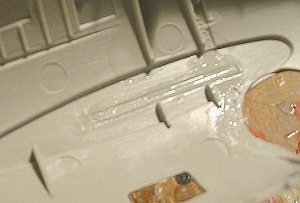 controls” is a waste of time. After making
sure the wings were straight, I set them aside.
controls” is a waste of time. After making
sure the wings were straight, I set them aside.
I then assembled the horizontal stabilizers
and elevators, and discovered the elevators could be posed “drooped.”
These were also set aside once assembled. I also glued the rudder halves
to their respective fuselage halves at this point.
Once the wings had set up, I glued them to their respective fuselage halves before further assembly of the fuselage. This way, I was able to work the joint from both inside and out, to get a firm connection without any gaps or subsequent need of putty. You should be careful when you do this, because the wings have a “natural fit position” that results in no dihedral. Once the joints were firm, but before they had set up, I rubber-banded the fuselage halves together and made sure to bend the wings up to get the proper dihedral. The Wildcat has quite a bit of dihedral, so this is very necessary, because a Wildcat with no dihedral would look as ridiculous as a P-51D Mustang with its canopy slid back into “open space.”
The next step was the cockpit. The color
call-outs in the instructions are totally wrong. Only General
Motors-built FM-1 and FM-2 Wildcats had Interior Green cockpits. All
Wildcats built by Grumman - which includes all F4F-4s - were painted
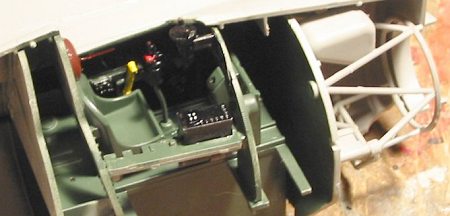 Bronze Green. I used Gunze Sangyo “Green,” FS34092, for this. I
finished detail painting in the cockpit by painting the various black
boxes, levers, throttles, etc., according to color photographs of a
restored F4F-4 in “F4F Wildcat in Detail and Scale.”
Bronze Green. I used Gunze Sangyo “Green,” FS34092, for this. I
finished detail painting in the cockpit by painting the various black
boxes, levers, throttles, etc., according to color photographs of a
restored F4F-4 in “F4F Wildcat in Detail and Scale.”
I then assembled the engine mount, attached it to the forward cockpit bulkhead, and painted everything in the wheel well Light Grey, for which I used Tamiya “Sky Grey.” I also painted the interior of the cowling and the accessories at the rear of the engine the same color. Sadly, Trumpeter does not include the very-obvious superchargers that are easily seen in the wheel well.
 With everything painted, I glued the interior
into the left fuselage half, then glued the fuselage halves together.
These didn’t want to go together easily, but with a bit of effort,
running glue along the centerline an inch at a time and pressing the
parts together, I was able to get the fuselage assembled without any huge
gaps. After scraping down the joint, I only needed a little bit of Mr. Surfacer to get rid of the centerline seam. I then attached the tail
surfaces and set the main assembly aside.
With everything painted, I glued the interior
into the left fuselage half, then glued the fuselage halves together.
These didn’t want to go together easily, but with a bit of effort,
running glue along the centerline an inch at a time and pressing the
parts together, I was able to get the fuselage assembled without any huge
gaps. After scraping down the joint, I only needed a little bit of Mr. Surfacer to get rid of the centerline seam. I then attached the tail
surfaces and set the main assembly aside.
I had already heard my share of complaints from other modelers about the engine. I was not about to build the model with the cowling left unpainted, since much of the rest of the engine assembly - like the intakes for the superchargers - isn’t there. I thus decided to follow my policy of “if you can’t see it, I didn’t do it.” This meant leaving off the exhaust system and the magnetos, which have made grown men cry as they try to assemble these and then get everything inside the cowling. I used only the engine cylinders and the crankcase assembly, which looks just fine and fit easily inside the cowling. Once all this was painted and assembled, I glued the engine and cowling to the front of the main assembly and the model was ready to be painted.
As you can see from the accompanying photo, once everything is assembled you really can’t see all the “missing” detail.
|
COLORS AND MARKINGS |
Painting:
 None of the colors the instructions suggest -
like “IJN Grey” for the lower surfaces and landing gear and “Intermediate
Blue” for the upper surfaces - are correct.
None of the colors the instructions suggest -
like “IJN Grey” for the lower surfaces and landing gear and “Intermediate
Blue” for the upper surfaces - are correct.
I Futured the canopy, glued the windscreen in
place and tacked the canopy closed with white glue. I masked these off,
then painted the canopy frame with Gunze-Sangyo Green 34092, as I had the
cockpit. I then “pre-shaded” the model,
 airbrushing flat black over all
the panel lines.
airbrushing flat black over all
the panel lines.
The lower surfaces were painted with Gunze-Sangyo “Light Gull Grey,” The upper surfaces were painted with Gunze-Sangyo “Blue-Grey,” which was then lightened with light grey to “sun fade” the model.
The landing gear was painted with the main gear leg light grey and the rest of the assembly flat black, which is correct for the Wildcat.
When all this was dry, I attached the landing
gear, and gave the model a coat of Future.
Decals:
Cutting Edge has released new 1/32 decals of the Wildcat, and I used sheet 32-039, “Wildcats of VMF-121, 221 & 223,” which includes the markings for Marion Carl’s “hangar queen” Wildcat he was photographed with at Espiritu Santo. The sheet provides kill markings for both sides, which was non-standard but was done this one time for the benefit of the photographers who were expected to be all around the airplane. They also got the score wrong - it should only be 17, not 19, so cut off the lower two in the last row to the right. As is usual with Cutting Edge decals, everything went down with no problem under a coat of Micro-Sol. When this was dry I gave the model a final coat of Future.
|
FINAL ASSEMBLY |
It is most likely that this airplane - which had been a “hangar queen” for quite some time, was not in the best condition, though probably not as weathered as an airplane in service on Guadalcanal. I decided to “ding” it around various panels and on the upper wing surface where pilots and maintenance personnel stood on the wing, and to add some oil stains. Once this was done, the model was given several coats of Testor’s Dullcote to obtain a final finish.
|
CONCLUSIONS |
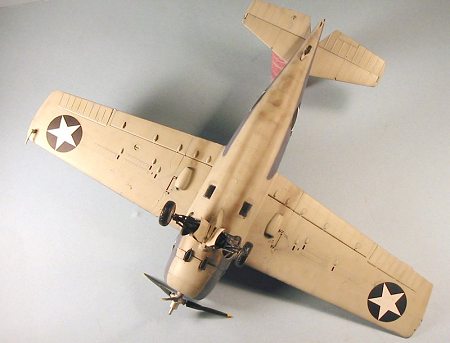 This kit is over-engineered in many places
where it doesn’t need to be, and then essential parts - such as the
superchargers and their intakes - aren’t provided. Following the kit
instructions results in a model which can only be finished with the wings
folded. I wish Trumpeter would look at their naval aircraft models and
do them the way Tamiya did their Corsair: with options that allow the
modeler to finish the kit with wings folded or wings extended. The last
time I tried to make a model with the difficult Grumman fold system in
which it was supposed to work was with the old Monogram Avenger - that
only held up for a few swings, and this system doesn’t work even as good
as that. Modelers who buy these kinds of kits are not looking for toys,
and Trumpeter should recognize that and do their production design in
light of that fact.
This kit is over-engineered in many places
where it doesn’t need to be, and then essential parts - such as the
superchargers and their intakes - aren’t provided. Following the kit
instructions results in a model which can only be finished with the wings
folded. I wish Trumpeter would look at their naval aircraft models and
do them the way Tamiya did their Corsair: with options that allow the
modeler to finish the kit with wings folded or wings extended. The last
time I tried to make a model with the difficult Grumman fold system in
which it was supposed to work was with the old Monogram Avenger - that
only held up for a few swings, and this system doesn’t work even as good
as that. Modelers who buy these kinds of kits are not looking for toys,
and Trumpeter should recognize that and do their production design in
light of that fact.
Overall, the model suffers for not having the lapped panels and raised rivet detail the real Wildcat had. Tamiya got this right with their kit, and the presence of such detail is very apparent in 1/48 scale - its lack is even more apparent in 1/32 scale. That said, the final result out-of-the-box certainly looks better than what one would get from the ancient Revell kit, thus making this kit from Trumpeter the hands-down best Wildcat available in 1/32 scale.
Thanks to Stevens International for the review kit.
If you would like your product reviewed fairly and quickly by a site that has nearly 250,000 visitors a month, please contact me or see other details in the Note to Contributors.